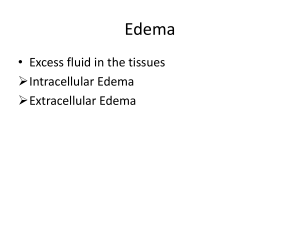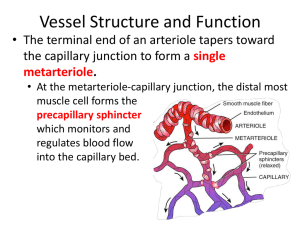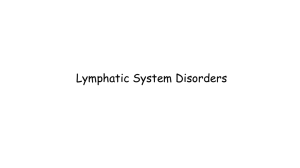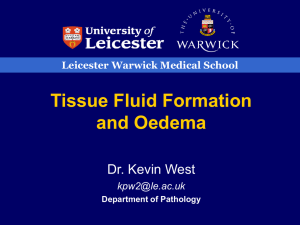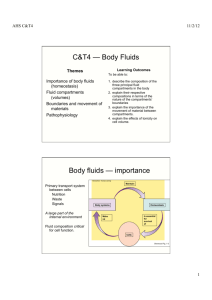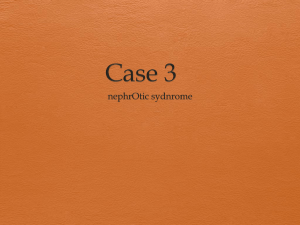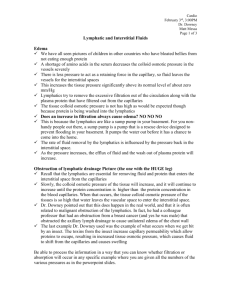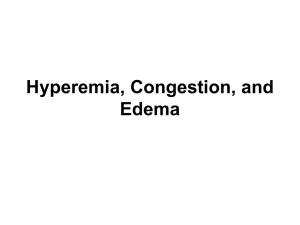Fluid Pressures
advertisement
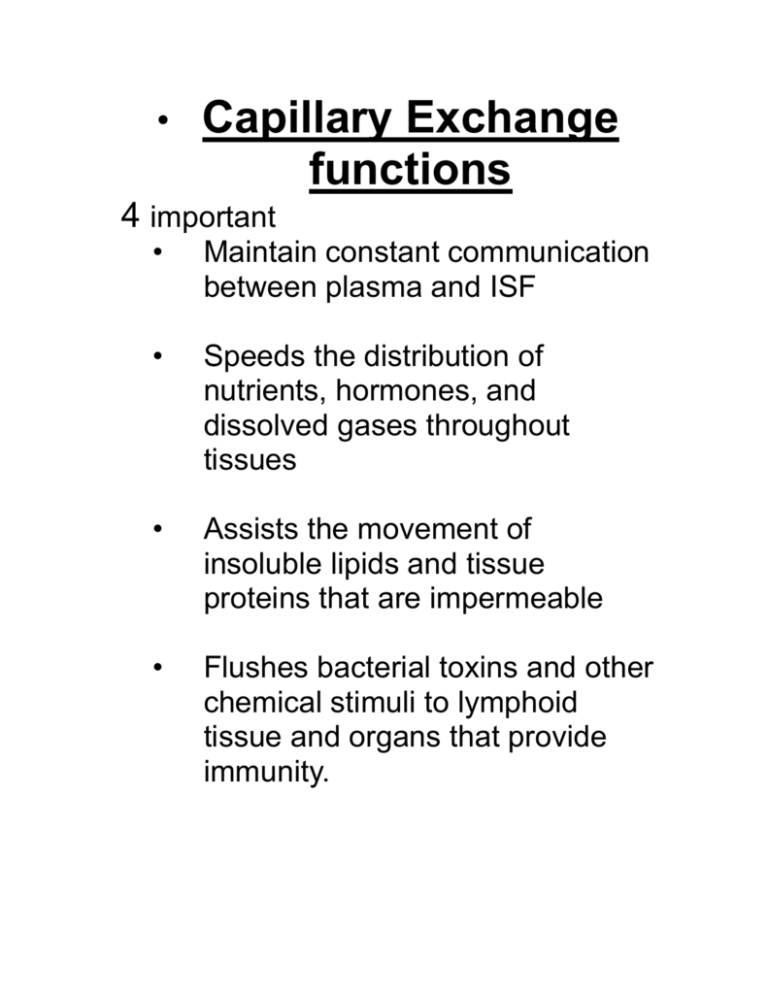
• Capillary Exchange functions 4 important • Maintain constant communication between plasma and ISF • Speeds the distribution of nutrients, hormones, and dissolved gases throughout tissues • Assists the movement of insoluble lipids and tissue proteins that are impermeable • Flushes bacterial toxins and other chemical stimuli to lymphoid tissue and organs that provide immunity. • Features of the blood capillaries: • 1 mm length. • 10 billion capillaries • TSA 500-700 sq; mts. • Wall is 0.5-1. µ thick • 25,000 miles -adult • 5 %of blood -flowing • Arteriolar ends – precapillary sphincters. • Flow slow intermittent,(0.5mm/sec) • Alternating periods of closure and opening which occur 6-12 times/ minute.( vasomotion.(O2) • Tissue Fluid • Fluid Pressures (Starling’s Law) Fluid flows only when there is a difference in pressure • 1st space shifting- normal distribution of fluid in both the ECF compartment and ICF compartment. • 2nd space shifting- excess accumulation of interstitial fluid (edema) • 3rd space shifting- fluid accumulation in areas that are normally have no or little amounts of fluids (ascites) Interstitial Fluid • • Fluid between cells Derived from capillaries • Solutes similar to plasma except for protein content • Movement Of Fluid Across Capillaries 5. Starlings factors;1.Capillary (hydrostatic) pressure 2.Interstitial fluid (hydrostatic) pressure 3.Plasma oncotic pressure 4.Interstitial fluid oncotic pressure 5. Negative Interstitial fluid pressure 6.Endothelial integrity 7.Lymphatic system Barriers separate ICF, interstitial fluid and plasma • • Plasma membrane • • Separates ICF from surrounding interstitial fluid Blood vessel wall • Separate interstitial fluid from plasma Balance Sheet Arterial/Venous Net out (Filtration pressure) 13 mmHg// (Reabsorption pressure) 7 mmHg Outward 1.Cap. pressure 30/10 mmHg 2. Negative interstitial fluid pressure 3/3 mmHg 3. Interstitial oncotic pressure 8/8 mmHg Total 41/21mmHg Inward Plasma oncotic pressure 28/28 mmHg • Oedema An increased volume of interstitial fluid in a tissue or organ • • • • Hydrostatic pressure Oncotic pressure Endothelial integrity Lymphatic integrity • 1. Raised Capillary Pressure Increase of capillary blood pressure (=increase of filtration force): 1.Cardiac edema, there is increase of the venous pressure increase of capillary BP increase of filtration edema. Cardiac failure • • • right ventricular failure - systemic oedema left ventricular failure - pulmonary oedema congestive cardiac failure – both 2.Local venous obstruction 1.Pregnancy edema (last months) large uterus --- on the iliac veins 2.Deep vein thrombosis 3.External compression 4.Superior Venous obstruction . • 2. Reduced Oncotic Pressure Decrease of the colloidal osmotic pressure of the plasma proteins (=decrease of reabsorption force): - - concentration of plasma proteins decreases to 5gm/dL or less, examples: a. Malnutrition edema due to decrease of protein intake in diet or decrease of absorption of food proteins from the small intestine. b. Renal disease due to loss of proteins in urine is called nephrotic syndrome. 3. Lymphatic Obstruction • 3. Obstruction of lymph vessels (=decrease of lymph drainage): Lymphatic obstruction decrease of lymphatic drainage from the affected part lack of drainage of excess tissue fluid which accumulates lymphatic edema, examples: a. Elephantiasis which is a marked lymphatic edema of the lower limbs due to - obstruction of their lymph vessels from inside by filarial worms (parasites). b. Obstruction of the lymph vessels by malignant cells (tumour). Edema occurs in the part drained by the obstructed lymph vessels. c. Tumours d. Fibrosis e.Inflammation 4. Increase of capillary permeability (= increase of filtration): • capillary dilatation due to release of vasodilator substances such as histamine & kinins, e.g. Allergic edema, Inflammatory 5.Surgery 6.Congenital abnormality • HYPERVOLUMIA NA+ and water retention (=increase of plasma volume): plasma volume increase of filtration through the capillary wall edema • • • - Excessive secretion of Aldosterone and glucocorticoids i.e, Cushing’s syndrome. Prolonged use of (cortisol) as a drug. In pregnancy due to high level of estrogen and progesterone. .
